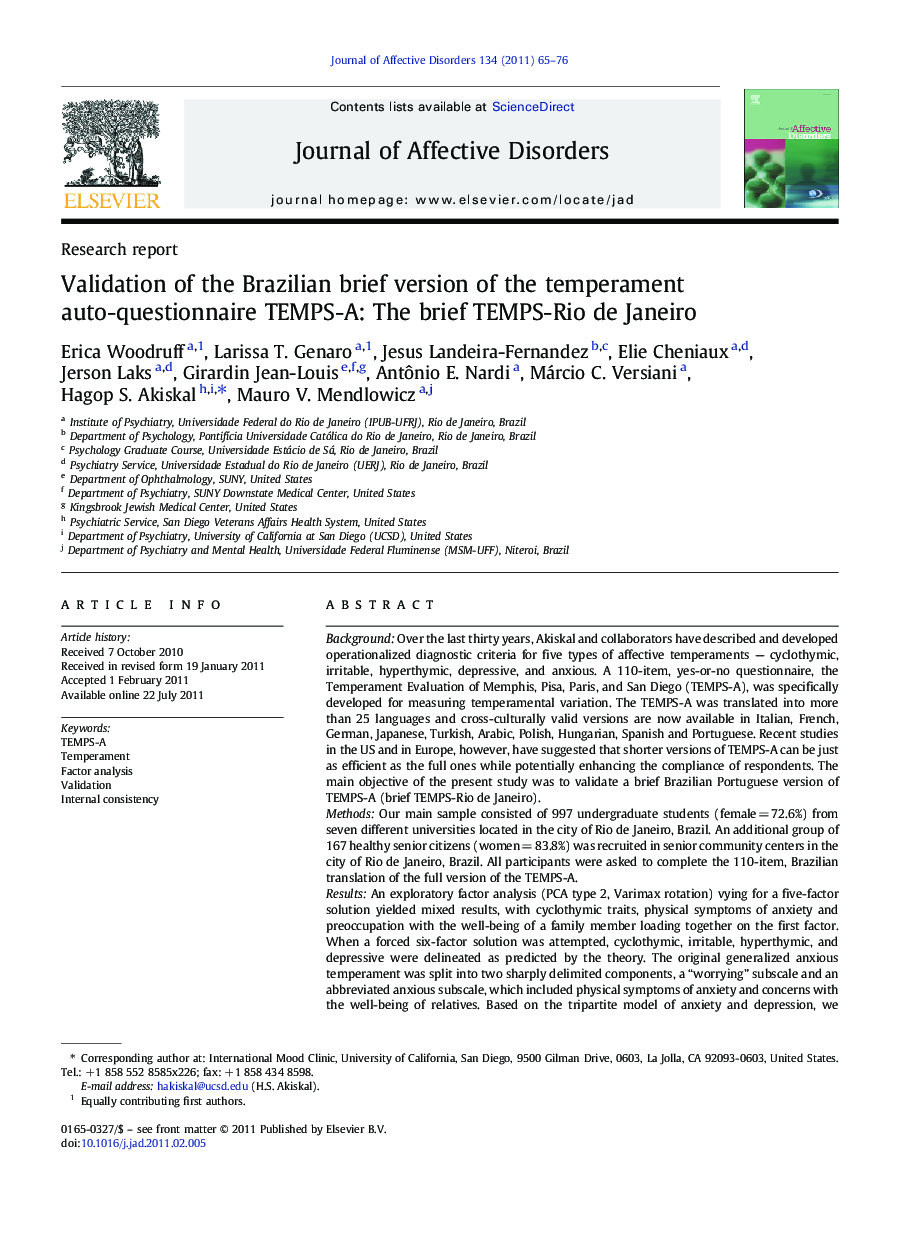| کد مقاله | کد نشریه | سال انتشار | مقاله انگلیسی | نسخه تمام متن |
|---|---|---|---|---|
| 6235117 | 1608185 | 2011 | 12 صفحه PDF | دانلود رایگان |

BackgroundOver the last thirty years, Akiskal and collaborators have described and developed operationalized diagnostic criteria for five types of affective temperaments - cyclothymic, irritable, hyperthymic, depressive, and anxious. A 110-item, yes-or-no questionnaire, the Temperament Evaluation of Memphis, Pisa, Paris, and San Diego (TEMPS-A), was specifically developed for measuring temperamental variation. The TEMPS-A was translated into more than 25 languages and cross-culturally valid versions are now available in Italian, French, German, Japanese, Turkish, Arabic, Polish, Hungarian, Spanish and Portuguese. Recent studies in the US and in Europe, however, have suggested that shorter versions of TEMPS-A can be just as efficient as the full ones while potentially enhancing the compliance of respondents. The main objective of the present study was to validate a brief Brazilian Portuguese version of TEMPS-A (brief TEMPS-Rio de Janeiro).MethodsOur main sample consisted of 997 undergraduate students (female = 72.6%) from seven different universities located in the city of Rio de Janeiro, Brazil. An additional group of 167 healthy senior citizens (women = 83.8%) was recruited in senior community centers in the city of Rio de Janeiro, Brazil. All participants were asked to complete the 110-item, Brazilian translation of the full version of the TEMPS-A.ResultsAn exploratory factor analysis (PCA type 2, Varimax rotation) vying for a five-factor solution yielded mixed results, with cyclothymic traits, physical symptoms of anxiety and preoccupation with the well-being of a family member loading together on the first factor. When a forced six-factor solution was attempted, cyclothymic, irritable, hyperthymic, and depressive were delineated as predicted by the theory. The original generalized anxious temperament was split into two sharply delimited components, a “worrying” subscale and an abbreviated anxious subscale, which included physical symptoms of anxiety and concerns with the well-being of relatives. Based on the tripartite model of anxiety and depression, we proposed that the abridged anxious subscale, which includes physical symptoms of anxiety, represents the “true” generalized anxious temperament, while the “worrying” subscale corresponds to the “general distress factor”. The internal consistency of the six subscales thus identified was generally good, ranging from 0.67 (anxious subscale) to 0.81 (worrying subscale), with cyclothymic, irritable, depressive, and hyperthymic subscales exhibiting intermediate values (0.74, 0.74, 0.72, and 0.7, respectively).LimitationsThe present study was based on a non-clinical sample that does not reflect accurately the characteristics of the Brazilian population. The relative uniformity of the sample in terms of age and education precluded a more in-depth analysis of the influence of these highly relevant factors. Further, we did not assess convergent, divergent or test-retest validity.ConclusionsWe believe that the brief Brazilian version of the TEMPS-A auto-questionnaire will provide Brazilian researchers and clinicians with a psychometrically sound instrument and thus contribute toward the creation of a worldwide research network dedicated to the investigation of affective temperaments.
Journal: Journal of Affective Disorders - Volume 134, Issues 1â3, November 2011, Pages 65-76